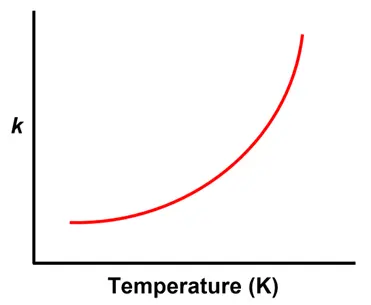The Arrhenius Equation: Understanding Temperature's Role in Reaction Rates
Note- In the previous article, we covered rate constant, considering it in relation to Arrhenius equations.
- In this article, let's explore Arrhenius equation separately in more detail.
The Arrhenius Equation and Its Components
The Arrhenius equation is expressed as:
$$
k = A e^{-\frac{E_a}{RT}}
$$
where:
- $k$: The rate constant, which determines the speed of the reaction.
- $A$: The Arrhenius factor(or frequency factor), representing the frequency of collisions with the correct orientation for a reaction to occur.
- $E_a$: The activation energy, the energy barrier that must be overcome for a reaction to proceed (measured in joules per mole, $\text{J mol}^{-1}$).
- $R$: The gas constant, $8.31 \, \text{J mol}^{-1}\ \text{K}^{-1}$.
- $T$: The absolute temperature in kelvin (K).
- $e$: The base of natural logarithms ($e \approx 2.718$).
This equation tells us two key things:
- As temperature increases ($T$), the term $-\frac{E_a}{RT}$ becomes less negative.
- This means $e^{-\frac{E_a}{RT}}$ increases, leading to a larger $k$, and thus a faster reaction.
- A higher activation energy ($E_a$) reduces $k$.
- Reactions with large activation energies are slower because fewer particles have enough energy to overcome the barrier.
The exponential term, $e^{-\frac{E_a}{RT}}$, represents the fraction of particles with enough energy to overcome the activation energy barrier at a given temperature.

The Linear Form of the Arrhenius Equation
- The Arrhenius equation can also be expressed in a linear form for easier analysis: $$
\ln k = \ln A - \frac{E_a}{RT}
$$ - This equation is in the form of a straight-line equation: $y = mx + c$, where:
- $y = \ln k$
- $x = \frac{1}{T}$
- The slope ($m$) is $-\frac{E_a}{R}$.
- The y-intercept ($c$) is $\ln A$.
- By plotting $\ln k$ against $\frac{1}{T}$, you can determine the activation energy ($E_a$) and the frequency factor ($A$) from the graph:




